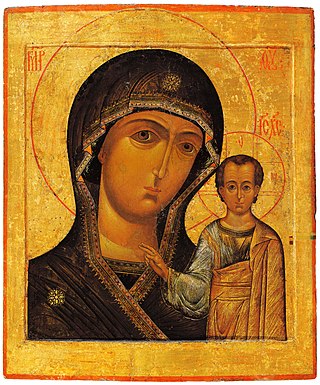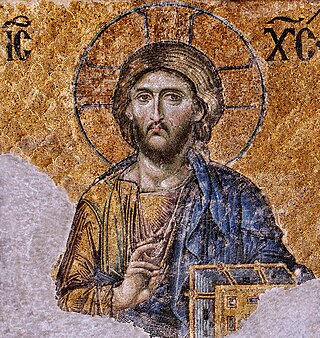
The Eastern Orthodox Church, also called the Orthodox Church and officially the Orthodox Catholic Church, is the second-largest Christian church, with approximately 260 million baptized members. It operates as a communion of autocephalous churches, each governed by its bishops via local synods. The church has no central doctrinal or governmental authority analogous to the head of the Catholic Church—the pope—but the Ecumenical Patriarch of Constantinople is recognized by them as primus inter pares. As one of the oldest surviving religious institutions in the world, the Eastern Orthodox Church has played a prominent role in the history and culture of Western Asia, the Caucasus, Eastern and Southeastern Europe.

Filioque is a Latin term added to the original Niceno-Constantinopolitan Creed, and which has been the subject of great controversy between Eastern and Western Christianity. It is a term that refers to the Son, Jesus Christ, with the Father, as the one shared origin of the Holy Spirit. It is not in the original text of the Creed, attributed to the First Council of Constantinople (381), which says that the Holy Spirit proceeds "from the Father", without additions of any kind, such as "and the Son" or "alone".

John Climacus, also known as John of the Ladder, John Scholasticus and John Sinaites, was a 6th–7th-century Christian monk at the monastery on Mount Sinai. He is revered as a saint by the Latin Catholic, Eastern Orthodox and Eastern Catholic churches.

Theotokos is a title of Mary, mother of Jesus, used especially in Eastern Christianity. The usual Latin translations are Dei Genitrix or Deipara. Familiar English translations are "Mother of God" or "God-bearer" – but these both have different literal equivalents in Greek, Μήτηρ Θεοῦ and Θεοφόρος.

The Jesus Prayer, also known as The Prayer, is a short formulaic prayer, esteemed and advocated especially in Eastern Christianity: "Lord Jesus Christ, Son of God, have mercy on me, a sinner." The prayer has been widely taught and discussed throughout the history of the Eastern Catholic Church and Eastern Orthodox Church. The ancient and original form did not include the words "a sinner", which were added later. It is often repeated continually as a part of personal ascetic practice, its use being an integral part of the eremitic tradition of prayer known as hesychasm. The prayer is particularly esteemed by the spiritual fathers of this tradition as a method of cleaning and opening up the mind and after this the heart, brought about first by the Prayer of the Mind, or more precisely the Noetic Prayer, and after this the Prayer of the Heart. The Prayer of the Heart is considered to be the Unceasing Prayer that the Apostle Paul advocates in the New Testament. Theophan the Recluse regarded the Jesus Prayer stronger than all other prayers by virtue of the power of the Holy Name of Jesus.

The Massacreof the Innocents is a purported incident in the nativity narrative of the Gospel of Matthew (2:16–18) in which Herod the Great, king of Judea, orders the execution of all male children who are two years old and under in the vicinity of Bethlehem. Christians venerate them as the first Christian martyrs. A majority of Herod biographers, and "probably a majority of [...] biblical scholars", hold the event to be myth or legend.

Flavia Julia Helena Augusta was an Augusta of the Roman Empire and mother of Emperor Constantine the Great. She was born in the lower classes traditionally in the Greek city of Drepanon, Bithynia, in Asia Minor, which was renamed Helenopolis in her honor, though several locations have been proposed for her birthplace and origin.

An exarch was the holder of any of various historical offices, some of them being political or military and others being ecclesiastical.

Saint Catherine's Monastery, officially the Sacred Autonomous Royal Monastery of Saint Katherine of the Holy and God-Trodden Mount Sinai, is an Eastern Orthodox Christian monastery located at the foot of Mount Sinai, in the Sinai Peninsula, Egypt. Built between 548 and 565, it is the oldest continuously inhabited Christian monastery in the world.

The Greek Orthodox Patriarchate of Jerusalem, also known as the Greek Orthodox Church of Jerusalem, is an autocephalous church within the wider communion of Eastern Orthodox Christianity. Established in the mid-fifth century as one of the oldest patriarchates in Christendom, it is headquartered in the Church of the Holy Sepulchre in Jerusalem and led by the Patriarch of Jerusalem, currently Theophilos III. The Patriarchate's ecclesiastical jurisdiction includes roughly 200,000 to 500,000 Orthodox Christians across the Holy Land in Palestine, Jordan and Israel.

El Tor, also romanized as Al-Tur and At-Tur and known as Tur Sinai, formerly Raithu, is a small city and the capital of the South Sinai Governorate of Egypt. The name of the city comes from the Arabic term for the mountain where the prophet Moses received the Tablets of the Law from God; this mountain is designated Jabal Al Tor.

Saint Nilus the Elder of Sinai was one of the many disciples and stalwart defenders of St. John Chrysostom.

January 13 - Eastern Orthodox liturgical calendar - January 15

The West Syriac Rite, also called the Syro-Antiochian Rite and the West Syrian Rite, is an Eastern Christian liturgical rite that employs the Divine Liturgy of Saint James in the West Syriac dialect. It is practised in the Maronite Church, the Syriac Orthodox Church, the Syriac Catholic Church and various Malankara Churches of India. It is one of two main liturgical rites of Syriac Christianity, the other being the East Syriac Rite.

The History of the Eastern Orthodox Church is the formation, events, and transformation of the Eastern Orthodox Church through time.
The Four Marks of the Church, also known as the Attributes of the Church, describes four distinctive adjectives of traditional Christian ecclesiology as expressed in the Niceno-Constantinopolitan Creed completed at the First Council of Constantinople in AD 381: "[We believe] in one, holy, catholic, and apostolic Church."
Julian the Hermit of Mesopotamia adopted the ascetic life during the reign of Roman emperor Julian the Apostate in the fourth century AD. Saint Julian dwelt in solitude near the river Euphrates.

The history of Eastern Orthodox Christian theology begins with the life of Jesus and the forming of the Christian Church. Major events include the Chalcedonian schism of 451 with the Oriental Orthodox miaphysites, the Iconoclast controversy of the 8th and 9th centuries, the Photian schism (863-867), the Great Schism between East and West, and the Hesychast controversy. The period after the end of the Second World War in 1945 saw a re-engagement with the Greek, and more recently Syriac Fathers that included a rediscovery of the theological works of St. Gregory Palamas, which has resulted in a renewal of Orthodox theology in the 20th and 21st centuries.

Stephen is traditionally venerated as the protomartyr or first martyr of Christianity. According to the Acts of the Apostles, he was a deacon in the early Church at Jerusalem who angered members of various synagogues by his teachings. Accused of blasphemy at his trial, he made a speech denouncing the Jewish authorities who were sitting in judgment on him and was then stoned to death. Saul of Tarsus, later known as Paul, a Pharisee and Roman citizen who would later become a Christian apostle, participated in Stephen's martyrdom.

The Church of Sinai is a Greek Orthodox autonomous church whose territory consists of St. Catherine's Monastery at the foot of Mount Sinai in Egypt, along with several dependencies. There is a dispute as to whether the church is fully autocephalous or merely autonomous. The church is headed by the Archbishop of Mount Sinai and Raithu, who is traditionally consecrated by the Greek Orthodox Patriarch of Jerusalem and also serves as abbot for the monastery. The current hierarch is Archbishop Damian.
















